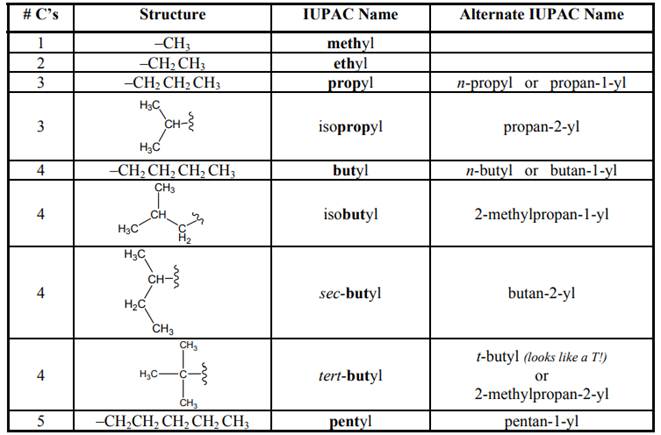
(a)
Interpretation: The IUPAC name for given structures of

Concept introduction: As per IUPAC recommendations longest chain found in a continuous manner in a branched molecule is chosen as parent chain.
The IUPAC name begins with prefix to designate the number of
Names of branches that occur commonly as side chains are listed below:

(b)
Interpretation: The structures of preceding ten branched alkanes should be reconstructed.
Concept introduction: As per IUPAC recommendations longest chain found in a continuous manner in a branched molecule is chosen as parent chain. Names of branches that occur commonly as side chains are listed below:

Want to see the full answer?
Check out a sample textbook solution
Chapter 2 Solutions
Organic Chemistry: Structure and Function
- Answer true or false. (a) Alkenes and alkynes are nonpolar molecules. (b) The physical properties of alkenes are similar to those of alkanes of the same carbon skeletons. (c) Alkenes that are liquid at room temperature are insoluble in water and when added to water, will float on water.arrow_forwardWrite structural formulas for compounds that meet the following descriptions:(a) An alkene, C6H12, that cannot have cis–trans isomersand whose longest chain is 5 carbons long(b) An alkene with a chemical formula of C10H12 that hascis–trans isomers and contains a benzene ring.arrow_forward(1) Write a complete chemical equation showing reactants, products, and catalysts needed (if any) for the following reaction and (2) Draw and name the organic compound found in every reaction. (a) Complete hydrogenation of 2-Methylhexa-1,5-diene (b) Complete halogenation (Br2) of 3-Ethyl-2,2-dimethylhept-3-ene (c) Reaction of (4E)-2.4-Dimethylhexa-1,4-diene with a mole of water (d) Reaction of cis-3,3-Dimethyl-4-propylocta-1,5-diene with two mole of HBr (e) Reaction of trans-1-Bromo-3-chlorocyclopentane with potassium hydroxide (f) Formation of Gilman reagent using isopropyl bromide (g) Ozonolysis of 3,3-Dimethyloct-4-yne (h) Complete halogenation (Cl2) of 3-Ethyl-5-methyl-1,6,8-decatriyne (i) Partial hydrogenation using Lindlar's Catalyst 2,2,5,5-Tetramethylhex-3-yne (i) Reaction of 3.4-Dimethylcyclodecyne with sodium amidearrow_forward
- 1. (a) Draw the structures of the eight isomeric pentyl alcohols, C3H11OH. (b) Name each by the IUPAC system and by the carbinol system. (c) Label each as primary, secondary, or tertiary, (d) Which one is isopentyl alcohol? tert-Pentyl alcohol? (e) Give the structure of a primary, a secondary, and a tertiary alcohol of the formula C,H13OH.arrow_forwardCompounds B and C are hydrocarbons with the structural formulae as shown below. CH, „CH, в (a) Name compounds B and C according to the IUPAC nomenclature. (b) Both B and C can undergo oxidation reaction with the same oxidizing agent. Write chemical equations involved and explain the differences between these two reactions. (c) Name one reaction that converts B to methylcyclohexane.arrow_forward1. (a) Draw structures of the seven isomeric alkynes of formula C6H10 - (b) Give the IUPAC and derived name of each. (c) Indicate which ones will react with Ag' or Cu(NH3)2.arrow_forward
- A certain hydrocarbon has a molecular formula of C5H8. Which of the following is not a structural possibility for this hydrocarbon? (a) It is a cycloalkane. (b) It contains one ring and one double bond. (c) It contains two double bonds and no rings. (d) It is an alkyne.arrow_forward(a) Write an equation involving structural formulas forthe catalytic cracking of 2,2,3,4,5,5-hexamethylhexane. Assume that the cracking occurs between carbon atoms 3 and 4.(b) Draw and name one other isomer of the alkene.arrow_forward(a) What structural feature is associated with each type of hy-drocarbon: an alkane; a cycloalkane; an alkene; an alkyne? (b) Give the general formula for each type .(c) Which hydrocarbons are considered saturated?arrow_forward
- Name and draw structural formulas for all alkenes with the molecular formula C5H10. As you draw these alkenes, remember that cis and trans isomers are different compounds and must be counted separatelyarrow_forwardTRUE OR FALSE (a) Both ethylene and acetylene are planar molecules. (b) An alkene in which each carbon of the double bond has two different groups bonded to it will show cis-trans isomerism. (c) Cis-trans isomers have the same molecular formula but a different connectivity of their atoms. (d) Cis-2-butene and trans -2-butene can be interconverted by rotation about the carbon–carbon double bond. (e) Cis-trans isomerism is possible only among appropriately substituted alkenes. (f) Both 2-hexene and 3-hexene can exist as pairs of cis-trans isomers. (g) Cyclohexene can exist as a pair of cis-trans isomers. (h) 1-Chloropropene can exist as a pair of cis-trans isomers.arrow_forwardThe melting points and boiling points of two isomeric alkanes are as follows: CH3(CH2)6CH3, mp = -57 °C and bp = 126 °C; (CH3)3CC(CH3)3, mp = 102 °C and bp = 106 °C. (a) Explain why one isomer has a lower melting point but higher boiling point. (b) Explain why there is a small difference in the boiling points of the two compounds, but a huge difference in their melting points.arrow_forward
 Chemistry: The Molecular ScienceChemistryISBN:9781285199047Author:John W. Moore, Conrad L. StanitskiPublisher:Cengage Learning
Chemistry: The Molecular ScienceChemistryISBN:9781285199047Author:John W. Moore, Conrad L. StanitskiPublisher:Cengage Learning
